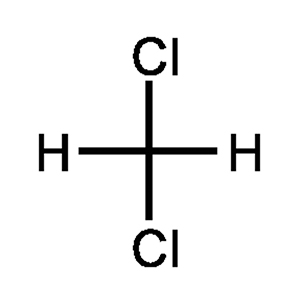
Methylene chloride, also known as dichloromethane, is a colorless liquid with a mild, sweet odor. It is widely used as an industrial solvent and as a paint stripper and can be found in certain aerosol and pesticide products and may also be found in some spray paints, automotive cleaners, and other household products.
CH2Cl2 84.93
Methane, dichloro-.
Dichloromethane --- [75-09-2].
Methylene Chloride contains not less than 99.0 percent of CH2Cl2.
[Caution: Perform all steps involving evaporation of methylene chloride in a well-ventilated fume hood. ]
Packaging and storage: Preserve in tight containers.
Identification: Place about 5 mL into a glass-stoppered, 10-mL conical flask, and shake for several minutes. Remove the stopper, quickly withdraw a portion of the vapor into a 50-mL syringe that is not fitted with a needle, and inject the vapor into a suitable evacuated gas cell: the IR absorption spectrum of the vapor shows strong doublet peaks at 7.8 5m and 7.9 5m and at 13.2 5m and 13.4 5m, and relatively few minor peaks.
Specific gravity: between 1.318 and 1.322.
Water: not more than 0.02%.
Limit of hydrogen chloride: Into each of 2 glass-stoppered, 50-mL color-comparison cylinders having an internal diameter of 20 mm place 10 mL of water, 2 drops of PhPh, and sufficient 0.010 N sodium hydroxide to produce a pink color that persists after vigorous shaking for 30 seconds, and is of equal intensity in each cylinder. [NOTE: In the following steps, take special care to avoid contamination with carbon dioxide.] Into one of the cylinders place 20.0 mL of Methylene Chloride and 0.70 mL of 0.010 N sodium hydroxide, and shake again. The pink color in the test cylinder is at least as intense as that in the comparison cylinder, and the color persists for not less than 15 minutes (0.001%).
Limit of nonvolatile residue: Evaporate 50 g in a platinum or porcelain dish on a steam bath, and dry at 105C for 30 minutes: the weight of the residue does not exceed 1 mg (0.002%).
Heavy metals: Evaporate 15 mL (20 g) in a glass evaporating dish on a steam bath to dryness. Cool, add 2 mL of hydrochloric acid, and slowly evaporate again on a steam bath to dryness. Dissolve the residue in 1 mL of 1 N acetic acid, add 24 mL of water, and mix: the limit is 1 ppm.
Free chlorine: To 10 mL add 10 mL of water and 0.1 mL of potassium iodide, shake for 2 minutes, and allow the liquids to separate: the lower layer does not show a violet tint.
Assay: By chromatographic system.
Dichloromethane; Methylene Dichloride
CH2Cl2 --- Formula wt 84.93
CAS: [75-09-2]
DESCRIPTION
Methylene Chloride occurs as a clear, colorless, nonflammable liquid. It is soluble in about 50 parts of water, and is miscible with alcohol, with acetone, with chloroform, and with ether.
Its refractive index at 20C is about 1.424.
Function: Extraction solvent.